Birds of Chimney Rock
Hummingbirds at the Feeders
Black-chinned Hummingbird: Medium hummingbird with metallic green upperparts, gray underparts, white breast, green-washed flanks. Head appears black overall with white spot behind eye; cap is very dark green. Throat is iridescent violet; bill is long and slightly decurved. Forked tail is dark green with black outer tail feathers. In cold weather, a Black-chinned Hummingbird may ingest three times its body weight in nectar in one day. The spider and insect silk holding the nest together stretches and allows the nest to expand along with the growing nestlings.
Broad-tailed Hummingbird: Medium hummingbird with green upperparts and flanks, iridescent red throat, and gray underparts. Dark green tail may show some rufous. Black bill is long and straight. Black legs, feet. Feeds on nectar, spiders, sap and insects. Direct and hovering flight with very rapid wing beats. A group of hummingbirds has many collective nouns including a bouquet, glittering, hover, shimmer, and tune. This species is reported to nest in the same spot each year, It will even build a new nest atop the old one. One female holds the North American age record for hummingbirds at twelve years old. The Broad-tailed Hummingbird enters torpor, a slowed metabolic state, on cold nights. It maintains a body temperature of about 54o when ambient temperatures fall below 44o F.
Calliope Hummingbird: Very small hummingbird, metallic green upperparts and flanks, white underparts. Throat feathers are long, purple-red, appearing as streaks on a white background, whiskers when fluffed out, or dark, inverted V when folded. Direct and hovering flight with very rapid wing beats. It prefers high mountains and has been seen as high as 11,000 feet. The Calliope Hummingbird is the smallest breeding bird in North America and the smallest long-distance avian migrant in the world. Named after the Greek muse Calliope, the Latin name Stellula means little star, given for the male’s streaked purple-red gorget over a white background.
Rufous Hummingbird: Medium hummingbird, bright rufous-brown overall with white breast and ear patch, red-orange throat, and green shoulders. Rounded tail is rufous with black edges. Some males show green on back and head. Feeds on insects and nectar. Direct and hovering flight with rapid wing beats. The Rufous has the longest migration route of all North American hummingbirds. It has an excellent memory for location. They have been observed investigating where an absent feeder was located the previous year. With sufficient food and shelter, this species has been known to survive in temperatures well below freezing.
Songbirds around the Visitor Cabin
American Goldfinch: Small, noisy finch. Male has a bright yellow body, black cap, wings, and tail, and white rump and undertail coverts. Wings have flashy white patches and bright yellow shoulder bar. Bill is conical. Undulating flight, alternates several rapid wing beats with wings pulled to sides. A group of goldfinches has many collective nouns, including a 007, charm, rush, treasury, and vein. They nest late, starting in late June or early July. Their late timing may be related to the availability of suitable nesting materials and seeds for feeding young.
Black-billed Magpie: Large, noisy jay, mostly black, with very long tail and dark, stout bill. Wings and tail are iridescent blue and green-black. White belly and sides. Eats insects, larvae, carrion. Direct flight on shallow, steady wing beats. Often glides between perches or from perch to ground. A group of magpies has many collective nouns, including a charm, gulp, mischief, tittering, and tribe. In the past, they have been considered vermin (due to feeding on poultry eggs and orchard crops) and farmers have placed bounties on them. They are now protected in the U.S. The Black-billed Magpie spends up to 40 hours building nests with domes on top. Unlike most birds, they can use scent to locate food.
Black-capped Chickadee: Medium-sized, stocky chickadee with pale gray upperparts and breast and pale olive-brown underparts. Conspicuous black cap, bib, and white cheeks. Black bill is short and thin. Wings are dark with broad white edges on feathers. A group of chickadees is known as a banditry or a dissimulation. Song is one of the most complex vocalizations of all animals, acting as a contact call, an alarm call, to identify an individual, or to indicate recognition of a particular flock. They may cache food in hundreds of sites, recalling the locations and retrieving food up to 28 days later.
Black-headed Grosbeak: Large, stocky finch, black-streaked, orange-brown back, black head, wings, tail. Breast is orange-brown and belly is yellow. Wings have conspicuous white patches. Black legs, feet. Forages on ground and in trees and bushes. Eats insects, caterpillars, seeds, fruits and berries. The Black-headed Grosbeak is one of the few birds that can safely eat the poisonous monarch butterfly. Their nests are so thinly constructed that eggs can be seen through the bottom. Thin nests may provide ventilation and help keep them cool.
Cassin’s Finch: Medium-sized with bright red crown, brown-streaked back, white belly, buff neck, upper breast and rump. Bill tapers evenly to a sharp point. Forages on ground and high in trees, eats mostly conifer seeds and buds, some insects. Swift bounding flight on rapid wing beats. A group of finches has many collective nouns, including a charm, company, and trembling. It craves salt and is often found visiting mineral deposits on the ground. The male Cassin’s Finch stays in its female-like plumage during its first breeding season. It sings like an older male and may give the false impression that both sexes sing. Named after John Cassin, a curator at the Philadelphia Academy of Natural Sciences.
Downy Woodpecker: Smallest woodpecker in North America, has a white back, black nape and black wings with white spotting. Underparts are white. Face is white with black stripes. Hindcrown patch is red. Tail is black with black-spotted or barred white outer tail feathers. Bill is black and short. A group of woodpeckers has many collective nouns, including a descent, drumming, and gatling. As the smallest North American woodpecker, it can drill cavities in dead trees or limbs that measure as little as 10 cm around. It can live in a wider range of habitat than larger woodpeckers. Males tend to feed in the tops of trees on branches that are small in diameter, females feed midlevel and lower on larger diameter branches. Uses sources of food that larger woodpeckers cannot, such as insects on weed stems.
Evening Grosbeak: Large, stocky finch, bright yellow back, rump, and underparts. Head is brown with heavy, pale bill; bright yellow eyebrows extend onto forehead. Dark wings with bold white secondary patches; dark tail. Feeds on insects, buds, sap, seeds, fruits, and berries. Swift bounding flight. A group of grosbeaks is known as a gross of grosbeaks. Evening Grosbeaks devour surprising quantities of raw salt. These fast-eating birds have been observed consuming 96 sunflower seeds in five minutes.
Hairy Woodpecker: Small woodpecker with black-and-white upperparts, white underparts. Head has red hindcrown patch. Face is white with black stripes. Tail is black with white outer tail feathers. Bill is long and black. Legs and feet are black. Has 17+ recognized subspecies. The males incubate the eggs during the night while the females incubate them during the day. They are the most prolific woodpeckers in North America.
Mountain Chickadee: Medium chickadee, gray upperparts, black cap and bib, white cheeks and nape, pale gray underparts. Wings and tail are gray, bill is black, legs and feet are gray-black. Its white eyebrow differentiates it from all other North American chickadees. Preferred habitats include dry coniferous forests. During summer, can also be found in high-elevation aspen forests. Nest cup is molded in fur and then plugged with looser fur. The un-incubated eggs are covered with the fur plug while the female is not in the nest.
Northern Flicker: Medium woodpecker, black-barred brown back, white rump, black tail. Underparts are black-spotted pale brown with black crescent on breast. Face is gray with brown crown and forehead. Legs and feet are gray. There are Red-shafted and Yellow-shafted races. A group of flickers is collectively known as a guttering, menorah, or Peterson of flickers. Northern Flickers use a drumming technique to attract a mate. Unfortunately, they often practice on the metal flues of fireplaces.
Pine Siskin: Small finch with brown-streaked body. Wings have small patches of yellow and two white wing-bars. Tail is dark, notched, and has small yellow patches. Bill is slender and pointed. Forages on ground and in trees for seeds and insects. Flight is swift and high, travels in compact flocks. The name Siskin is derived from its sound or chirp. Thus, this bird’s common name is really pine chirper. Most common of the irruptive winter finches. When eating from conifers, it usually hangs upside down from the tips of the trees.
Pygmy Nuthatch: Small nuthatch, blue-gray upperparts and pale yellow breast. Head has a dark gray-brown cap, pale spot on nape, and thick black eye-line; throat is white. Legs and feet are gray. Weak fluttering flight, alternates rapid wing beats with wings drawn to sides, usually of short duration. A group of nuthatches is collectively known as a jar. It is one of only two nuthatch species in the world known to have helpers at the nest. Offspring from previous years help parents raise young. No record exists of these birds roosting alone. They always huddle in a group of as many as 100 in a single cavity.
Red Crossbill: Medium finch with red-orange body, brighter red rump, and dark brown wings. Bill is dark and crossed at tip. Tail is notched. Legs and feet are gray-black. Eats seeds, insects and caterpillars. Swift bounding flight, alternates rapid wing beats with wings pulled briefly to sides. A group of crossbills is known as a crookedness or warp. Eight different flight call types have been described and birds giving each type have slightly differently shaped bills. It is so dependent on conifer seeds it even feeds them to its young. It can breed any time it finds a sufficiently large cone crop, even in winter. They show a great deal of variation in bill shape and voice, and may in fact be composed of several different species.
Spotted Towhee: Large sparrow, white-spotted black back, black rump. Black breast, white belly, rufous sides. Head is black and eyes are red. Wings are black with white spots. Tail is long and black with white corners. Short, bounding flights, alternates rapid wing beats with wings pulled to sides. A group of towhees is known as a tangle or teapot. They occasionally sun themselves, lying down on the grass with feathers spread. They often bathe in dew or fog drip on vegetation. When disturbed, a nesting female may run away like a mouse rather than fly.
Steller’s Jay: Large, crested jay, dark gray upperparts, head and breast, blue rump and belly. Head has slight white eyebrow, forehead, and chin spots. Wings and tail are blue with black bars. Feeds on pine seeds, acorns, fruit, frogs, snakes, carrion, insects, and eggs and young of other birds. A group of jays has many collective nouns, including band, cast, party, and scold. Although the reason is not known, they are occasionally observed far outside their normal range. Most of these far-flung individuals appear to be young birds. The Steller’s Jay and the Blue Jay are the only New World jays that use mud to construct their nests. They form flocks outside of the nesting season and often fly across clearings in single file.
Western Scrub-Jay: Medium, crestless jay, blue head, wings, tail, gray mask and back, pale gray underparts. Dark-streaked, white throat bordered by dark necklace. Bill, legs, feet are black. Eats grains, fruits, insects, frogs, lizards, and eggs and young of other birds. Flies with steady wing beats. A group of jays may be called a band, cast, party, or scold. Western Scrub-Jays have the ability to hide and remember where they put seeds.
Western Tanager: Medium-sized tanager with brilliant red head, bright yellow body, black back, wings, and tail. Wings have two bars: upper bar is yellow, lower bar is white. Legs and feet are gray. Swift direct flight on rapidly beating wings. It was first recorded on the Lewis and Clark expedition. A group of tanagers is collectively known as a season. The red pigment in the face is not produced by the bird but is acquired through their diet of insects that acquire the color from plants. Breeds farther north than any other member of its mostly tropical family, breeding in the Northwest Territories.
Birds on the Tour Trail
Clark’s Nutcracker: Medium, noisy and inquisitive jay with pale gray head and body. Black bill is long and stout. Wings are black with white patches, tail is black with white edges. Feeds on nuts, insects, eggs and young of other birds, lizards, carrion and small mammals. Steady deep wing beats. A group of nutcrackers has many collective nouns, including a ballet, booby, jar, and suite. The Clark’s Nutcracker has a special pouch under its tongue in which it carries pine seeds long distances to cache them. Depending on the species of pine seed, this pouch will hold from 28 and 90 seeds. First observed in 1805 by William Clark of the Lewis and Clark expedition, and bears his name. Unusual among members of the crow family, males of this species have brood pouches just like the females and help incubate the eggs. Nestlings are fed pine seeds from the parents’ caches. This allows the adults to breed as early as January or February despite the harsh winter weather in their range.
Peregrine Falcon: Medium robust falcon with blue-gray upperparts, plain breast, heavily barred sides, belly, and leggings. Head has a black hood and sideburns. Yellow fleshy eye ring. Yellow legs and feet. Feeds primarily on birds which it takes in midair after a steep, swift dive from above. A group of falcons has many collective nouns, including a bazaar, eyrie, ringing, stooping up, and tower. The Latin name peregrinus means “coming from foreign parts” which is fitting because they have one of the longest migrations of any North American bird. At 175 mph or more, the Peregrine Falcon is the fastest bird on record when in diving posture (called a stoop). These falcons were given Endangered Species status after decimation of the population from exposure to DDT in insecticides. A successful recovery effort resulted in removal from the U.S. list in 1999.
Turkey Vulture: Medium vulture, mostly black with red, featherless head and upper neck. Wings are held in a shallow V in flight. One of the few birds of prey able to use its sense of smell to find food, their keen sense of smell allows them to find dead animals below a forest canopy. They are attracted to the smell of mercaptan, a gas produced by the beginnings of decay. Like other carrion birds, they are protected from disease associated with decaying animals by a very sophisticated immune system. A group of vultures has many collective nouns, including cast, committee, meal, vortex, and wake. Like its stork relatives, it often defecates on its own legs, using the evaporation of the water in the feces to cool itself.
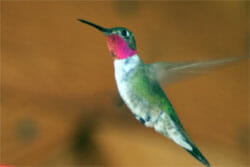
Broad-tailed Hummingbird
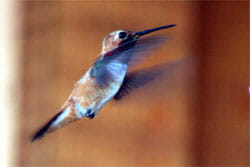
Rufous Hummingbird
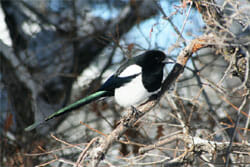
Black-Billed Magpie
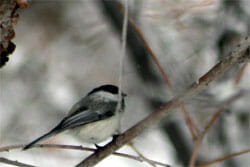
Black-capped Chickadee
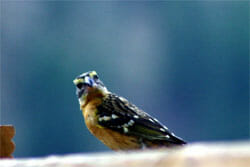
Black-headed Grosbeak
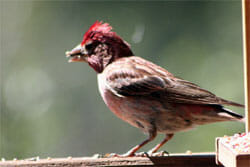
Cassin’s Finch
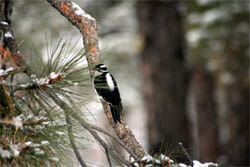
Downy Woodpecker
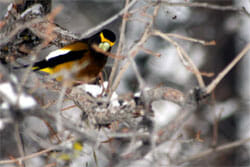
Evening Grosbeak
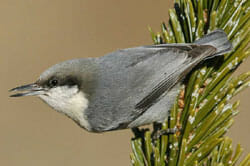
Pygmy Nuthatch
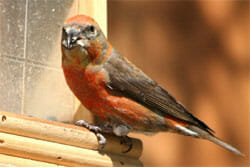
Red Crossbill
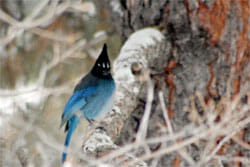
Steller’s Jay
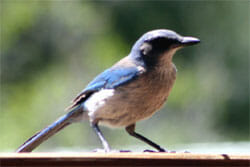
Western Scrub-Jay

Peregrine Falcon

